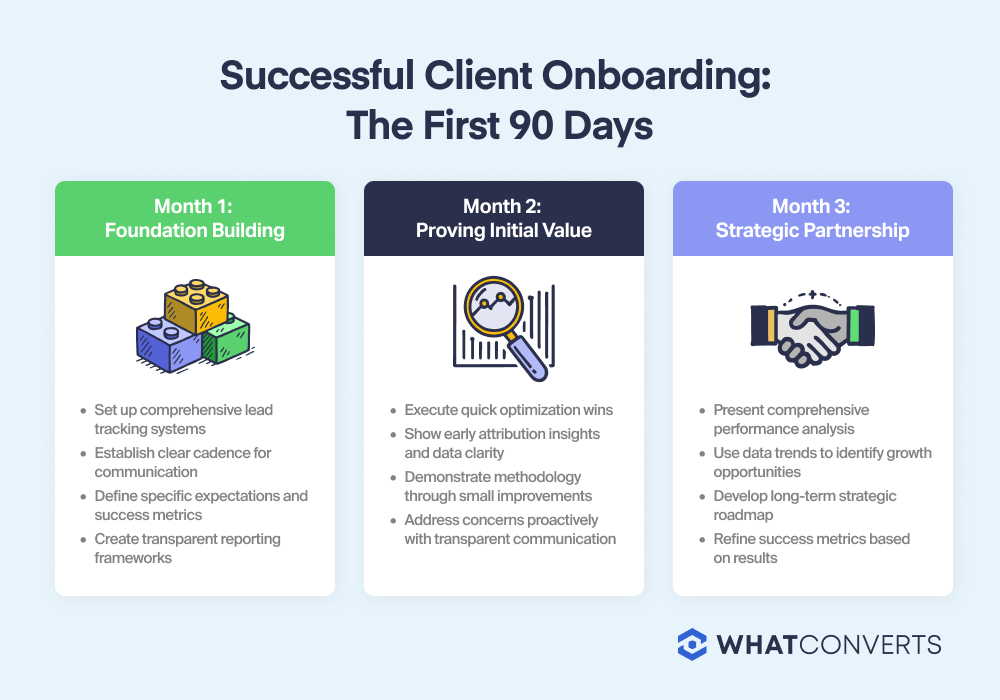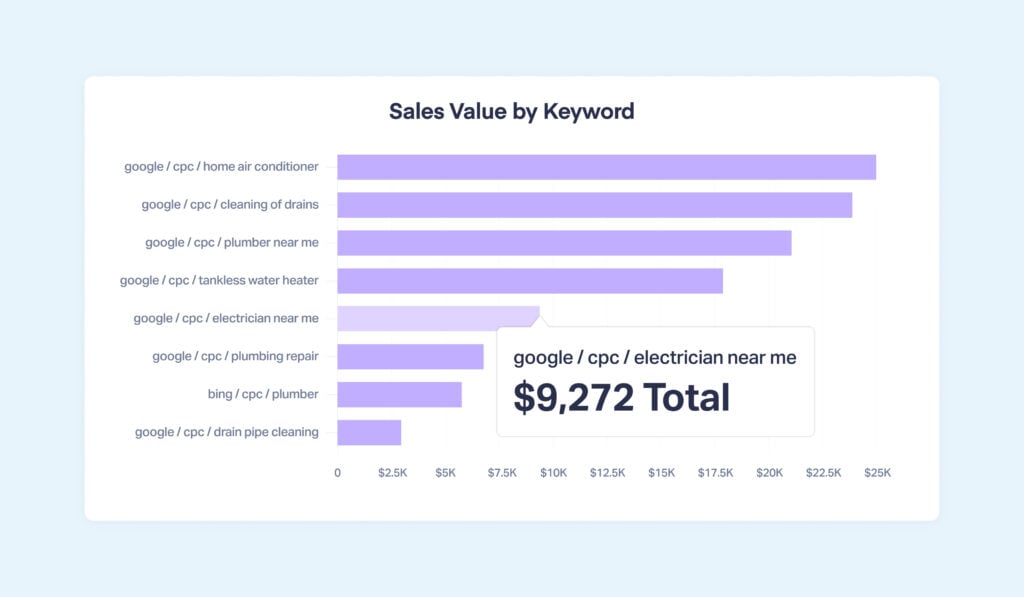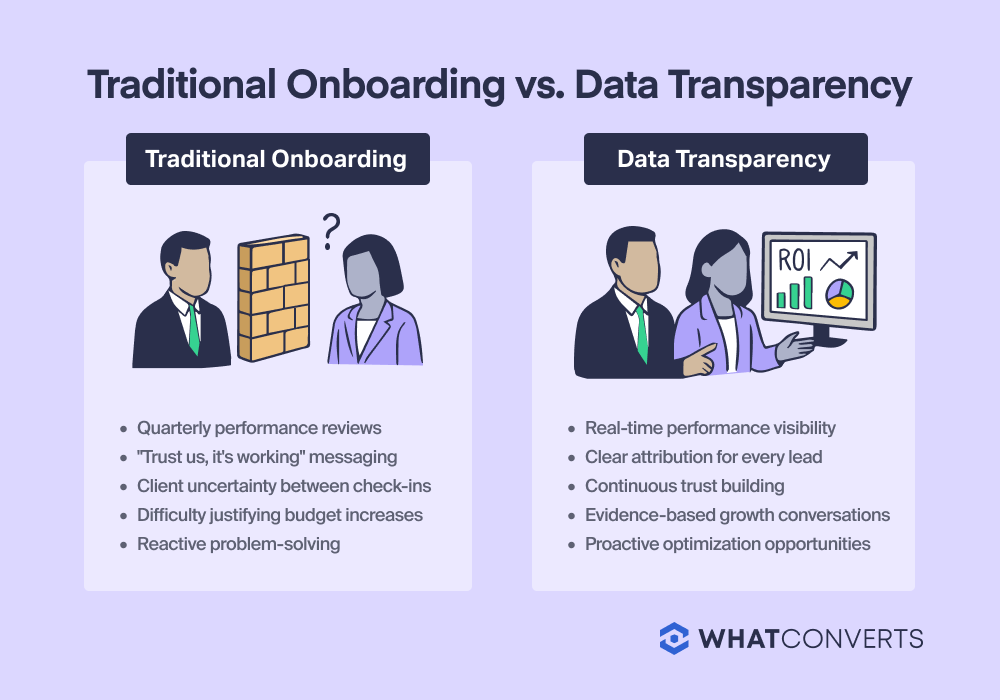
The first 90 days of a client relationship determine everything that follows.
Get onboarding right, and you build the foundation for a long-term partnership. Get it wrong, and you're fighting an uphill battle for trust that you may never win.
So how can you tell if your onboarding process is building trust or creating friction?
Effective client onboarding takes more than just good intentions and regular check-ins. It requires a strategic framework built on clear metrics that creates concrete value at every stage—one that can transform clients from skeptical buyers into confident partners.
Why Onboarding Makes or Breaks Client Relationships
The psychology behind successful client relationships is surprisingly straightforward: first impressions matter, but sustained value delivery matters more.
The problem is that traditional onboarding focuses on completing processes rather than demonstrating the value of the work completed. Agencies check boxes—access granted, tools configured, initial meetings held—without measuring whether these activities actually build client confidence.
Read More: Sector45’s Secret to Client Retention: Evolving from Vendor to Partner [Case Study]
The 90-Day Onboarding Framework Overview
Successful client onboarding follows a predictable pattern across three distinct phases, each with specific objectives and measurable outcomes:
Month 1: Alignment and Foundation Building
Focus on establishing trust, setting expectations, and creating the infrastructure for long-term success.
Month 2: Implementation and Initial Wins
Demonstrate tangible value through quick wins while building toward more substantial improvements.
Month 3: Optimization and Strategic Partnership
Use accumulated data and insights to optimize performance and plan for future growth.
Month 1: Setting the Foundation
The foundation phase is about more than paperwork and access credentials—it's about establishing the data infrastructure that will guide your entire relationship.
Start with Strategic Alignment
Your kickoff meeting should focus on understanding the client's definition of success, not just their immediate needs. Ask specific questions about their goals, current challenges, and how they measure marketing effectiveness. This conversation reveals not just what they want to achieve, but how they think about measurement and accountability.
Establish Data Transparency from Day One
One of the most powerful trust-building moves you can make is setting up comprehensive tracking systems as part of your foundation building. This isn't just about implementing tools—it's about demonstrating your commitment to transparency and measurable results.
When you install tracking systems that capture lead data across all channels, you're showing clients that you're confident enough in your work to measure everything. This approach immediately differentiates you from agencies that talk about results but avoid detailed measurement.
Create Communication Frameworks
Establish regular reporting cadences that focus on actionable insights rather than vanity metrics. Set up weekly check-ins during the first month, but make sure each conversation includes specific data points about campaign performance, lead quality, or attribution insights.
The goal isn't just to stay in touch—it's to demonstrate ongoing value through the insights you provide. When clients see that every interaction with you includes new information they can act on, they start viewing you as a strategic partner rather than a service provider.
Set Up Success Measurement Systems
During the foundation phase, establish the reporting frameworks that will guide your entire relationship. This includes not just campaign metrics, but lead quality indicators, attribution data, and ROI measurements that connect your work to business outcomes.
This early investment in measurement infrastructure pays dividends throughout the relationship. Clients who understand exactly how your work contributes to their bottom line are more likely to increase budgets, extend contracts, and refer other clients.
Read More: Advanced Reporting Helps Agency Earn $1M MRR for Client [Case Study]
Month 2: Delivering Initial Value
The second phase is where theoretical potential becomes measurable reality. Your goal is to demonstrate clear ROI through specific improvements that clients can see and quantify.
Identify and Execute Quick Wins
Quick wins aren't just about easy improvements—they're about demonstrating your methodology through tangible results. Focus on areas where comprehensive tracking reveals immediate optimization opportunities.
For example, you might discover through lead tracking that certain keywords generate significantly higher-quality prospects than others. By reallocating budget toward these high-performing keywords and showing the resulting improvement in lead quality, you demonstrate both your analytical capabilities and your impact on business outcomes.
Show Before and After Attribution
One of the most powerful ways to demonstrate value is through before-and-after attribution analysis. When clients can see exactly how their lead sources have improved since you started tracking comprehensively, the value of your work becomes undeniable.
This might involve showing how lead attribution clarity has revealed previously hidden top-performing channels, or how better tracking has eliminated wasted spend on campaigns that generated low-quality leads. The key is using specific data to tell the story of improvement.
Address Early Concerns Proactively
Use your tracking data to identify potential issues before they become problems. If you notice declining lead quality from specific sources or campaigns that aren't performing as expected, address these concerns directly with data-backed explanations and optimization plans.
This proactive approach demonstrates that you're not just monitoring performance—you're actively working to improve it. Clients appreciate partners who surface problems along with solutions rather than waiting for quarterly reviews to discuss challenges.
Celebrate Measurable Improvements
When your optimization efforts produce results, make sure clients understand both what has improved and why. If lead quality increases, show the specific changes that drove improvement. If conversion rates improve, explain the attribution insights that guided your optimization decisions.
This isn't just about taking credit for improvements—it's about helping clients understand how strategic measurement and optimization create lasting value.
Month 3: Strategic Partnership Development
By the third phase, you should have accumulated enough data to demonstrate comprehensive value and plan strategically for future growth. This phase transforms client relationships from service delivery to strategic partnership.
Present Comprehensive ROI Data
Use the 60-90 day period to compile comprehensive performance reports that justify continued partnership and potential budget increases. This includes not just campaign metrics, but business impact measurements that connect your work to revenue growth.
Show how improvements in lead quality translate to better sales outcomes, how attribution clarity has enabled smarter budget allocation, and how ongoing optimization continues to drive results. The goal is demonstrating that your partnership creates compounding value over time.
Identify Expansion Opportunities
Use lead value trends and attribution data to identify opportunities for service expansion. If certain marketing channels are driving exceptional results, that might justify expanding efforts in those areas. If attribution analysis reveals gaps in the current strategy, those gaps represent growth opportunities.
This data-driven approach to expansion conversations feels collaborative rather than sales-driven. You're using shared performance data to identify mutual opportunities for growth.
Develop Long-term Strategic Plans
With comprehensive attribution data and performance trends in hand, you can develop strategic recommendations that extend well beyond the initial scope of work. This might include new channel opportunities, advanced attribution strategies, or optimization approaches that build on early successes.
The key is using accumulated data to make recommendations that feel inevitable rather than opportunistic. When clients can see how your strategic recommendations flow logically from performance data, they're much more likely to approve expanded engagements.
Refine Success Metrics
As you learn more about the client's business and how different marketing activities impact their goals, refine your success metrics to focus on what matters most. This might mean shifting from lead volume to lead quality metrics, or from campaign performance to overall marketing ROI.
This evolution in measurement demonstrates that you're learning and adapting based on results rather than applying a one-size-fits-all approach. Clients value partners who continuously refine their approach based on data and experience.
Turning Data Transparency into Trust
The most successful client relationships are built on a foundation of data transparency that starts from day one. When clients can see exactly where their leads come from, which campaigns drive the best results, and how your optimization efforts impact their bottom line, skepticism transforms into confidence.
Building Confidence Through Attribution Clarity
Showing clients precise lead attribution from the very beginning eliminates the guesswork that creates client anxiety. Instead of wondering whether their marketing investment is working, clients can see real-time data that connects every lead to its source. This immediate clarity builds confidence faster than any amount of reassurance or explanation.
When clients understand exactly which keywords, campaigns, and channels generate their highest-quality leads, they stop questioning whether your recommendations are based on solid data. They can see for themselves which marketing activities drive results and which ones need adjustment.
The Compound Effect of Transparency
This transparency advantage compounds over time. Clients who understand the complete attribution picture of their marketing become more willing to test new strategies, increase budgets, and expand partnerships because they can measure the impact of these decisions.
The compound effect works because transparency eliminates the trust barriers that typically slow down client relationships. Instead of building trust through months of successful campaign management, you demonstrate trustworthiness immediately through data openness.
Eliminating Data Silos
Unified lead tracking eliminates the data silos that create client uncertainty. When all lead types—calls, forms, chats, and conversions—are tracked and reported in one place, clients get a complete picture of their marketing performance rather than fragmented snapshots from different tools.
This comprehensive view prevents the confusion that comes from trying to piece together performance data from multiple platforms. Clients can see sustained performance trends that build confidence in long-term partnership value, rather than wondering whether individual campaign improvements are real or temporary.
The result is better strategic conversations. Instead of defending campaign performance or explaining away disappointing results, you can focus discussions on optimization opportunities and growth strategies based on shared performance data that both parties trust completely.
Securing a Competitive Advantage Early On
The competitive advantage belongs to agencies that can show clients exactly how their marketing is performing from day one, then use that data to drive ongoing optimization and strategic growth. When onboarding focuses on building this measurement foundation, client relationships transform from transactional service delivery to strategic partnership.
This measurement-driven approach creates a sustainable competitive advantage because it's difficult for competitors to replicate. While other agencies might match your tactical capabilities, they can't easily duplicate the trust and transparency that comes from comprehensive measurement and clear attribution.
The agencies that master measurement-driven onboarding don't just retain clients longer—they grow those relationships faster and generate significantly higher lifetime value from every partnership. In an increasingly competitive market, this measurement advantage might be the most important differentiator you can build.
Ready to start improving your tracking and reporting process? Watch our pre-recorded demo or start your 14-day free trial today.
Get a FREE presentation of WhatConverts
One of our marketing experts will give you a full presentation of how WhatConverts can help you grow your business.
Schedule a Demo
Grow your business with WhatConverts








